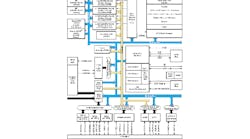Optimized for three-phase sensored or sensorless motor control, Texas Instruments’ C2000 Piccolo TMS320F2805x microcontrollers (MCU) implement the company’s InstaSPIN-FOC technology for field-oriented control and InstaSPIN-MOTION for motor control. Both InstaSPIN technologies are built into the chips’ read-only memory (ROM), which TI says reduces development time from months to minutes. Among their integrated analog control peripherals are a 12-bit analog-to-digital converter (ADC), 14 pulse-width-modulation (PWM) channels with fault management, seven windowed analog comparators with 10-bit digital-to-analog converters (DACs), dual zero-pin oscillators, and up to four programmable gain amplifiers (PGAs) and three fixed-gain amplifiers. InstaSPIN-MOTION SpinTAC components help ensure optimum tracking and disturbance rejection, and reduce complexity with single coefficient tuning. Furthermore, they produce an automatically optimized motion profile based on start velocity, target velocity, and system limitations for acceleration, jerk, and motion trajectory type. The MCUs’ 60-MHz C28x CPU includes up to 128 kbytes of flash and up to 20 kbytes of SRAM. Also incorporated are interfaces such as an SPI module, I2C bus, CAN 2.0, and three SCI/UART modules.
Sponsored Recommendations
Sponsored Recommendations
Comments
Comments
To join the conversation, and become an exclusive member of Electronic Design, create an account today!
Sponsored
Sponsored

